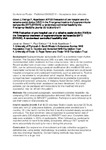PP23 Evaluation of pre-hospital use of a valsalva assist device (VAD) in the Emergency treatment of supraventricular tachycardia (SVT) [EVADE]. A randomised controlled feasibility trial.
| dc.contributor.author | Green, Jonathan | |
| dc.contributor.author | Ewings, P | |
| dc.contributor.author | Appelboam, A | |
| dc.date.accessioned | 2019-12-13T11:56:36Z | |
| dc.date.available | 2019-12-13T11:56:36Z | |
| dc.date.issued | 2019-04-02 | |
| dc.identifier.uri | http://hdl.handle.net/10026.1/15249 | |
| dc.description.abstract |
Background Supraventricular tachycardia (SVT) is a common heart rhythm disorder. The Valsalva Manoeuvre (VM) is a safe, internationally recommended, initial treatment, but has a low success rate in normal practice. Recent studies have shown much better cardioversion rates, approaching 50%, can be achieved using a postural modification (the modified VM) and a manometer controlled 40 mmHg strain. Successful cardioversion could avoid hospital conveyance and unpleasant treatments, such as adenosine. Routine use of a manometer is not practical out of hospital. Blowing on an empty syringe has been suggested as an alternative but is unreliable in providing correct and consistent pressures. A Valsalva Assist Device (VAD), designed to provide a 40 mmHg strain resistance has been developed. It is small, portable, can be packaged with instructions for the modified VM and if successful, may be left with the patient. Methods We conducted a pragmatic, randomised controlled feasibility trial, comparing VAD versus standard practice delivered VMs. All other aspects of care were according to SWASFT guidelines. Participants were followed up to ask their views on trial procedures. Interim results (month 5 of 6) 23 volunteer Station Leads recruited 22 Study Clinicians from 27 ambulance stations. 29 patients were enrolled over 5 months, 19 in the last 2 months (the first 3 months included steady recruitment and setup). The later enrolment rate extrapolates to a presentation rate of approximately 220 eligible patients to SWASFT each year. Complete data sets were available in 100% of participants. When followed up, participants reported verbal consent to be widely acceptable, although SVT symptoms were substantially distracting for many during this process. Conclusion Our experience of recruitment and data collection suggest a definitive trial, using similar methodology, is possible, but the low occurrence rate may challenge feasibility. Consent taking methods may require refinement for a larger trial. | |
| dc.language.iso | en | |
| dc.subject | Heart Disease | |
| dc.subject | Clinical Research | |
| dc.subject | Cardiovascular | |
| dc.subject | Clinical Trials and Supportive Activities | |
| dc.title | PP23 Evaluation of pre-hospital use of a valsalva assist device (VAD) in the Emergency treatment of supraventricular tachycardia (SVT) [EVADE]. A randomised controlled feasibility trial. | |
| dc.type | presentation | |
| dc.identifier.doi | 10.1136/emermed-2019-999abs.23 | |
| plymouth.organisational-group | /Plymouth | |
| plymouth.organisational-group | /Plymouth/Faculty of Health | |
| plymouth.organisational-group | /Plymouth/Research Groups | |
| plymouth.organisational-group | /Plymouth/Research Groups/Plymouth Institute of Health and Care Research (PIHR) | |
| plymouth.organisational-group | /Plymouth/Users by role | |
| plymouth.organisational-group | /Plymouth/Users by role/Academics | |
| dc.publisher.place | 999 EMS Research Forum | |
| dc.rights.embargoperiod | Not known | |
| rioxxterms.versionofrecord | 10.1136/emermed-2019-999abs.23 | |
| rioxxterms.licenseref.uri | http://www.rioxx.net/licenses/all-rights-reserved | |
| rioxxterms.type | Other |


